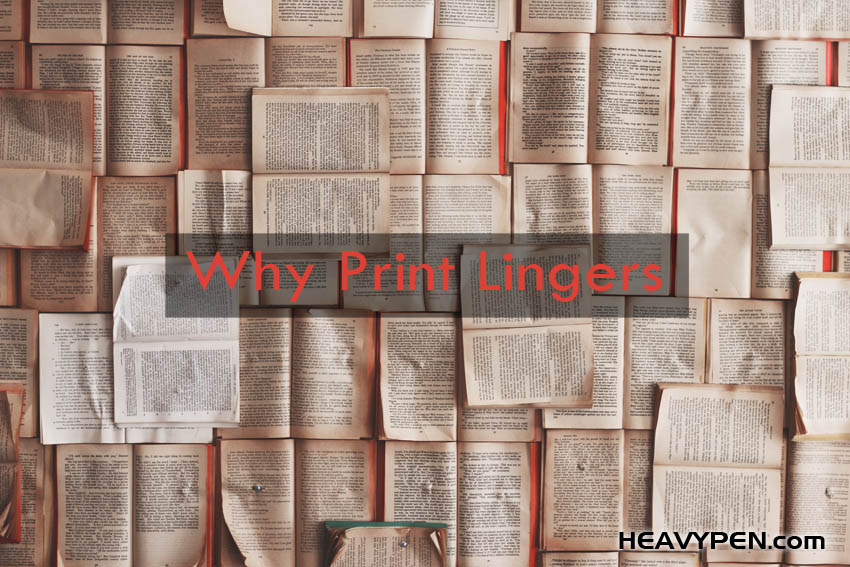
Why Print Lingers: And why your content strategy MUST still include print.
What did they say when the “information super-highway” was first launched? Oh yeah. “Print is dead.”
At one point, it seemed like print had almost died. But as it turned out, people love the ‘feel’ of information in their hands. We discovered that no matter how you work and where you get MOST of your news, we still long for the smell of newsprint, the portability of a slick magazine to tuck under your arm, and the comfort of an excellent book to cozy up with. One thing that the Net did was it produced a sea change for print. But the move made us realize — caused us to rediscover — the simplicity of popping open a container filled with printed pages to read.
The very bottom line of the competition for digital content versus print is that there’s no competition at all. The reason we cling to print has nothing to do with the convenience of the Internet. And this realization ought to profoundly impact all content development plans.
Right around 2010, after nearly a decade of steady declines, a fantastic thing happened. According to the Publishers Information Bureau (PIB). Both total magazine pages and rate-card-reported revenue posted gains. Then, another amazing thing happened. PIB reported in 2017 that growth continues to pick up – especially in select interest areas (science, hobby, self-help, news) and other active vertical markets. And print continues to be a major international business concern, growing from $332 billion in 2023 to more than $342 billion in 2024.
Moreover, magazine audiences grew, and young adults led the way, with most of the population identifying as ‘heavy’ readers. Young readers (18+) grew more than 4% over the previous five years, just as older audiences (50 and up) increased by almost 11% in the same period. And know what? These segments are still growing!
As of 2023, 223.6 million Americans read magazines in both print and digital. In 2021, the total number of adults who read magazines was 222 million, an astonishing increase of 5.46% from 2021. I say “astonishing” because, for a supposedly dead medium, a print media survey conducted by News Media Alliance shows that 90.4% of all surveyed adults read magazine media and that the core age group that reads magazines in the United States is between 18 and 34. By the way, Facebook has yet to break the 80% barrier for any age group.
The truth is… readers still love print.
I read untold thousands of words daily – all from my various monitors and digital displays. My eyes cannot keep up with the strain. I need a break from the glare and the lumens. There’s the computer at work, the computer at home, the flat panel TV, the mobile phone, cameras, pads — and my watch. Sometimes, when I look at faces, I imagine seeing pixels.
At various times and for various reasons, more than one doctor has recommended that I take a break from my electronic world. I had a bad time with carpal tunnel once, so I invested in a left-handed trackball, curved keyboards, unique chairs, and other special stuff. The arms and hands feel better, but you can’t hide your eyes from the glare. Now, my neck is killing me. They call THAT “text neck” from peering down at all that digital jazz. And now my eyes.
The pro-digital pundits thought they were safe with their ominous predictions about print after 91 North American magazines closed their doors in 2014, up from 51 the previous year. And in the present market, newspapers are still on their way out. Those that didn’t close decreased issue frequency by 25% or more. Newspapers suffered quite a bit during the same interval, with a total 49% drop in ad revenue in 2013, a huge decline over the previous decade (Pew Research). Meanwhile, Tribune Co. and other major publishers cut their payrolls and dolled out layoffs. They’re still laying off writers and support staff and consolidating operations.
Print gallantly fought back by raising subscription prices to offset at least some of the losses in dropping ad revenues. The smart ones invested heavily in digital delivery platforms to help enrich both advertisers’ and subscribers’ access to content. Magazines, at least, have seen a return to profitability. The road back to profitability will be a long, narrow, and bumpy for newspapers still groping for their market share.
Despite the gloom, print hung on. One element of surprise: the fact that despite the drop in circulations, many publications enjoyed a smaller, more dedicated readership who eagerly engaged the medium and interest in the content (a big positive for advertisers). For that reason, print remained “interesting” because people were provoked into picking it up and really looking at it. People buy print because they’re invested in the information portrayed by the cover, the headlines, and the photos. Digital doesn’t do that. In the time it takes to read one print magazine article, readers have skimmed two or three on digital platforms, distracted by email, popups, popunders, and all that sensational clickbait.
‘Dwell Time’ to the rescue?
Various readership surveys flow like rivers; everyone wants to know WHY print persists in a digital world. In one survey, respondents overwhelmingly cited the tangible experience of print as a positive experience. According to various studies cited by AdWeek, PR News, BusinessWeek, and other publications, most adults (not just Boomers, by the way) prefer to read print and paper communications rather than read from a screen. The last bit gives perspective to the most recent PIB data: apparently, younger adults have a greater attention span than the stereotype may lead us to believe.
Another power-up for print is the projected personality of longer articles, uninterrupted by animated ads and other distractions. In digital media, publishers must fill every available space with ads to break even. In print, the full-page ad at the start of the feature article and the fractional ads at the end are about all you see. And NO animation! Print also brings you the long feature story, 5,000 words or more of well-done narratives, compelling storytelling, and excellent authorship. By the end of the article, you know a great deal about the writer and the topic.
This brings me to the all-important ‘dwell time’ that marketers love. We want people to dwell on our content – to soak up more information. The average dwell time for an informational website is about 3-4 minutes. Six minutes if you’re very good. Social media pulls higher numbers – exceeding an hour or more, but here again, your message competes in a cacophony of words – which is the whole point of social media. Amid the printed pages of a newspaper or magazine, people may dwell 15-20 minutes in one sitting. Try to generate THAT kind of engagement on a webpage. Seriously. Just try.
Good old-fashioned ink.
I believe I’m hitting the tip of the berg (for example, audience attitudes toward all print – i.e., product brochures, printed galleries, profiles). However, I believe this information is enough to end the mythology that print is passé. Readers are not extinct, and YOUR audience will read content in a wholly non-interactive media – easy to read without distractions. This leads me to another observation: there is a wanting audience of readers who crave discovery, new information, ideas, and concepts while thumbing through printed paper pages. Yes, there’s always time for browsing and sifting through the online guano, where you hope audiences will find your website. But there’s also time for viewers to be handed material because they asked for it or have shown interest.
Riddle yourself this question: if print still works, what does this say about your content development strategy? Have you allowed for print? Do you have any offerings that go beyond PDF documents? Have you developed collateral brochures? Pamphlets? A book? Print has portability. Print encourages the ultimate portability of human-to-human interaction from good old-fashioned ink on paper.
Why print lingers is because it still meets the basic marketing paradigm: it serves a valuable purpose. I suppose there will come a day when 100 perfect bound pages of 80-pound gloss stock will be as rare as a rotary phone, but it hasn’t happened yet. And if the stats hold the current trends – it’ll be quite a while before we honestly say, “print is dead.”
Keep reading!
About: Ray Wyman, Jr is a content creator, communications professional, and author with more than 30 years of experience. Visit LinkedIN or Raywyman.com for more information.


